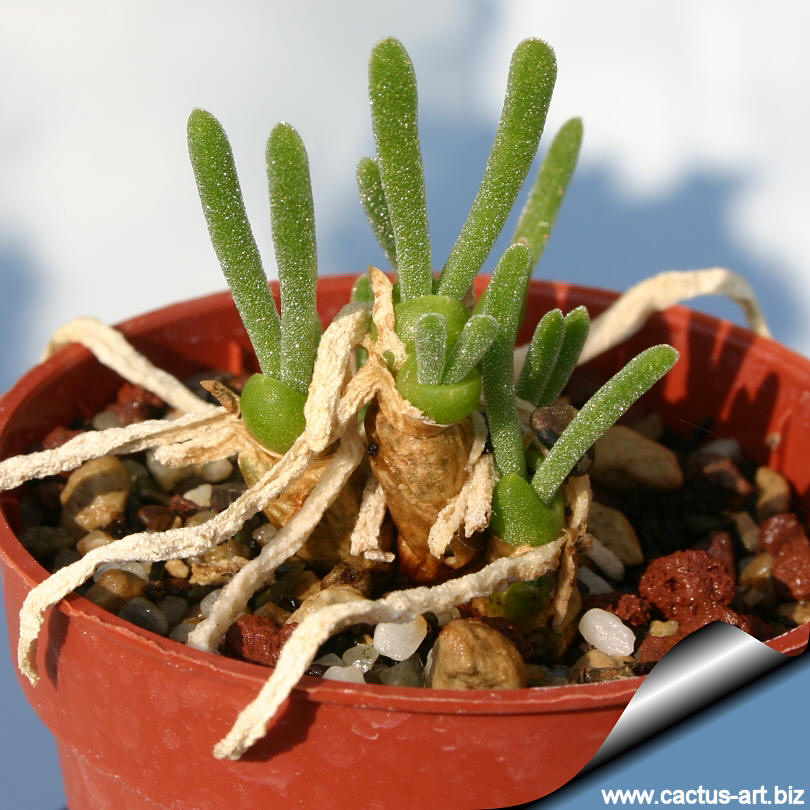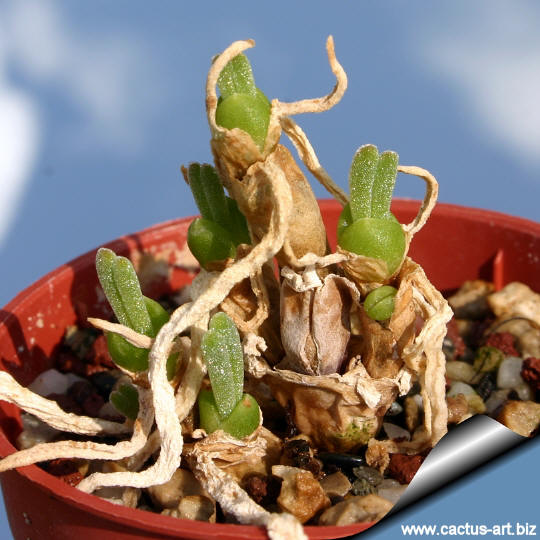|
|
|

Monilaria obconica
The small
glittering pearls on the leaves are special water storage cells rich in
sugars characteristic of succulents, in Monilaria these cells may be
½ a mm in diameter and can retain their moisture for weeks when
separated and exposed to dry air.
|
|
Description:
It is a smallish
clump-forming succulent plant. It is a seasonal
deciduous species and
has also both succulent leaves and stems.
Stem: Short branched with a beaded structure.
Leaves: Spaghetti-like green that eventually turn red in sun. The small
glittering pearls on the epidermis are
special water
storage cells rich in sugars characteristic of succulents,
in Monilaria these cells may be half a mm in diameter and can retain
their moisture for weeks when separated and exposed to dry air.
The possession of two different leaf forms (heterophylly) is a also a
distictive characteristic of Monillaria (and of Mitrophyllum) the leaf
pair formed at the start of the dormant season being more united and
compact than that formed when in full growth, and acting as a protective
sheath to the stem apex.
Flowers: It has spectacular rose flowers.
Propagation: It can be
reproduced both by cuttings and seeds. Take the cutting from a grown-up
mother plant. Each cutting must contain one or
more branches along with a fraction of root.
|
|


Advertising
|
|
|
|
Family:
Mesebrianthemaceae
(Aizoaceae)
|
|
Scientific name: Monilaria
obconica H.D.Ihlenfeldt &
S.Jorgensen
Origin: Monilarias
are endemic to Namaqualand.
(South Africa)
Habitat:
Grows over small hills on
quartz fields supports in drought-prone
microenvironments in winter rainfall regions.
Ecology: They are seasonal or drought-induced deciduous plants.
Deciduousness is a common adaptational strategy in aboveground
persistent succulent species native of arid areas of South Africa.
|
|
Synonyms:
|
|
|
|

New signs of turgidity and green colour at their extremities in autumn after the summer resting period. It
is a very interesting and easily flowered plant with brilliant green spaghetti
leaves.
Cultivation: It is relatively easy to grow. These plants grow on
winter rain and head for summer dormancy. The
growing season in northern hemisphere is from September to March.
Water minimally in summer. Water regularly
in winter after the new
long green leaves appears at their extremities in autumn after the
summer resting period. Requires
good drainage. It enjoy
some shade (avoid direct sun as it grows wild among rocks and under the
shade of other plants) and in summer it need to be kept in a cool area.
Hardy to -2°C.
Ensure a very good ventilation. Avoid to repot frequently. This plant
may stay in the same pot for many years. Plants grown in larger
containers have frequently relatively poor flowers. It might improve
when the plants are given their own, small individual pots.
Be careful not to apply too much fertilizer .
|
|